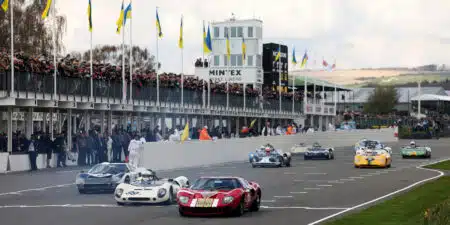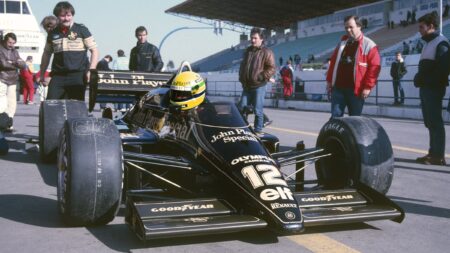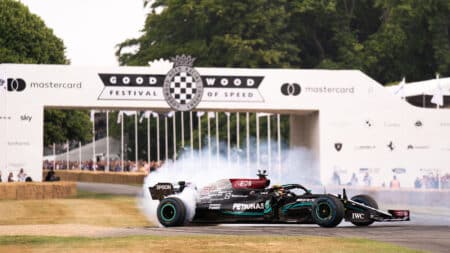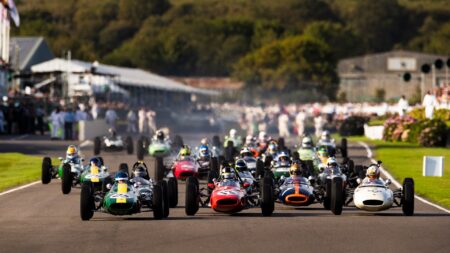
Watch live: 82nd Goodwood Members' Meeting live stream
Live stream this weekend's 82nd Goodwood Members' Meeting — plus timetable, streaming schedule and what to watch out for
Comparing two decade-defining cars: the ’70s Ford Capri versus the ’80s Ford Sierra
For more on the RS3100 Capri, pick up a copy of the March issue of Motor Sport
When it comes to saloon and touring car racing of the last 50 years or so, Ford has always been at the forefront. During the meat of the 1980s the Blue Oval’s weapon of choice was the Sierra; specifically the be-winged RS500 Cosworth. Prior to the Sierra it was that most ‘70s of working class icons, the Capri.
It’s no secret I adore the days of the RS500 in the BTCC and ETCC. Indeed one the highlights of my time thus far at Motor Sport was driving one of the black and orange Eggenberger Sierras for a couple of laps at last year’s Goodwood Members’ Meeting.
It was far from a full track test. Actually, I barely got heat into the slicks, but it was a fabulous and fascinating experience. Not least because I was surprised by the similarities between it and one of my other all-time favourite Ford racers, the Group 2 GAA Cologne Capri – an example of which I’m very fortunate to have spent the last few seasons racing.
Built to very different technical regulations, the pair share the same origins. That’s to say highly evolved race cars born from high-performance road cars that were themselves created specifically to satisfy exacting homologation requirements.
Both boast Cosworth-developed engines with hugely increased power outputs – the Capri’s bespoke 3.4 litre V6 good for 460bhp, the Sierra’s heavily turbocharged in-line 4-cyl around 550bhp. That’s close to three times the power of the road cars on which they are based.
Aerodynamics are another defining feature. Thanks to the more relaxed Group 2 regulations the Capri boasted broad, wind tunnel honed wheel arches, a deep shovel nose and exaggeratedly upswept tail, of which only an approximation of the boot spoiler was shared by the RS3100 road car. Being a Group A car, Ford had to put all the wind tunnel work into the RS500 road cars, but the famous bi-plane rear wing was no less dramatic for that.
The biggest difference between the two Fords is the amount of rubber each presents to the track surface. The Capri benefits from tyres more befitting of a Le Mans prototype or single-seater than a tin-top. By contrast, the RS500 was restricted both by Group A’s regulations and simply to what could fit within the Sierra’s showroom bodywork.
Having raced the Capri for two seasons I’m much more intimately acquainted with how it feels and performs, but those few laps in the RS500 revealed some striking similarities. One is the weight of the controls – especially the clutch and gearshift. Both require real strength to operate, but the upside is brilliantly quick and accurate shifts, plus a dog-leg first gear for maximum nostalgia and race-bred functionality.
Though the engines couldn’t be more different, both have very peaky deliveries. The GAA V6 needs plenty of revs wound into it (between 5500 and 6000rpm) before it comes on-cam, from which point it screams to 8500rpm with near-DFV ferocity. Needless to say, it sounds sensational.
By contrast, the RS500 motor has an almost industrial bellow. Unmistakably turbocharged, it sounds hollow and feels lethargic at lower revs, but as the boost builds its lungs fill, hardening the delivery and consuming the remaining revs in a flash.
Consequently, neither car is especially easy to drive, largely because you have to try and mitigate against the on-off power delivery. Having chatted to Steve Soper about his time in the Eggenberger-built car I drove, it sounds like the Sierra would be harder to race than the Capri, simply because the slam of torque easily overwhelms the modest rear tyres. It must have been so tempting to light the thing up out of every corner, but as is so often the case, winning a race in the RS500 was more about tyre conservation than crowd-pleasing.
The Capri will slide – indeed a modest slip angle is useful in keeping the revs up – but it always has a depth of traction and grip to last the hour-long race format favoured by the main historic touring car series. And, because the GAA doesn’t develop much in the way of torque it doesn’t wring the life out of the rear tyres in the manner of the RS500’s turbocharged motor.
In terms of raw spectacle, I think the Capri probably just trumps the Sierra, though only by the slimmest of margins. Which would be better to race? Having never raced the RS500 I can’t speak from experience (Hint-hint to anyone out there who fancies letting me have a go), but having read plenty about the days of the Capris and lived through the days of Soper, Rouse et al in the Cossies, I’d have to say its the Sierras – and Group A regs generally – that gave us the closer and more memorable racing. God bless the 80s!
What is ‘80s month? Motor Sport is going all ‘80s in print this month – available here – and so the website is following suit. Read about the turbo’s last hurrah, why Group C was sports cars’ best era and much more all month

Live stream this weekend's 82nd Goodwood Members' Meeting — plus timetable, streaming schedule and what to watch out for

In 1985, Ayrton Senna claimed his first grand prix victory aboard the Lotus 97T. 40 years on, that same car is set to roar again at the 2025 Goodwood Members’ Meeting

Here's everything you need to know about the 2025 Goodwood Festival of Speed, including how to get tickets and how to watch from home

The 2025 Goodwood Revival once again turns the clock back to the 1950s and 1960s with thrilling, evocative racing, a celebration of all things vintage, and parades that celebrate Alfa Romeo and the Volkswagen Type 2